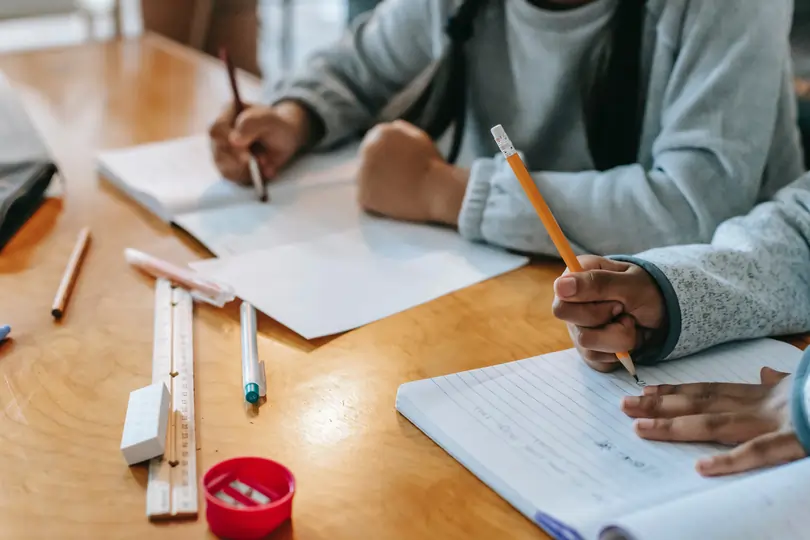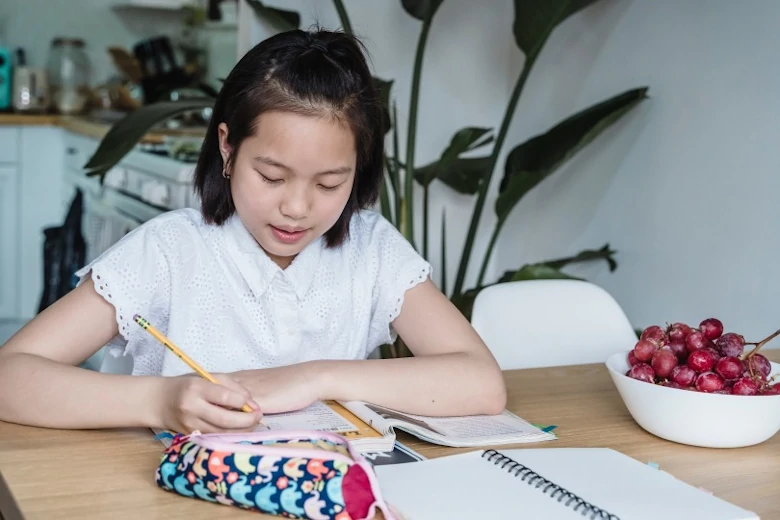Composition Writing - Introductions and Endings

In this article, we will discuss composition writing with a focus on introductions and endings. We will be addressing this topic from the standpoint of the Primary 6 English level, even though you have been writing compositions for a few years now.
Composition Writing
In this article we will go through the basics of the following topics:
- Introductions
- Endings
Introductions
You are taking your reader on a journey….
- Start beautifully, with them as the focus. Place your reader as the #1 priority.
- Not a time to show off your vocabulary with superfluous descriptions.
- Give enough detail; not too much, not too little.
Practice questions on introductions
Let us try some questions.
Question 1:
You have booked a hotel for your holiday. Which of the following is the best introduction you could receive?
- You are met at the airport where the staff takes all your bags and chauffeur you to the hotel in a fancy car.
- The manager sits you down and lists down all the things the hotel has to offer.
- There is nobody around and you struggle to figure out what to do.
- The hotel staff all stare at you like you are some sort of parasite.
Solution:
1
Explanation:
Option 1 - focuses on ‘you’ - the reader. That is the requisite of a good introduction. It helps to make the reader feel good and gets their attention. Here the reader is made to feel nice by the helpful and pleasant staff of the hotel. It ensures that the reader will have an enjoyable and memorable holiday.
Option 2 - focuses on ‘the manager’ and ‘the hotel’. The manager is not worried about the state of the reader: how long they had travelled to reach there; are they tired, are they comfortable at the hotel, etc. The manager is only concerned with himself and the importance he attaches to himself by boasting about his hotel and its amenities. It is a selfish way to introduce.
Option 3 - is not very optimistic. When you go on a holiday, you want to have a good time and not be stranded somewhere. If that is the case, you will never go back there ever again, and neither will you recommend your family and friends to go there.
Option 4 - is also completely on the negative side. The reader will not like to even read any further. They will be put off by the first line itself.
Question 2:
Likewise, how should a good introduction feel from the perspective of a reader? (Imagine you are the reader.)
- The descriptions are clear and easy to understand and you know what is going on.
- The descriptions are vague and you have no idea who is doing what.
- There are many impressive words but you feel a bit annoyed because you do not understand them. Constantly referring to the dictionary is tedious.
Solution:
1
Explanation:
When you speak or write in simple English, the readers can easily understand it and the actual intent or the idea comes across much more easily. Some of the best stories are written in simple English.
Question 3:
Now that you have seen things from the perspective of the reader, pick the best introduction for the topic “An Excellent Vacation”.
- The cerulean sky harkened back to a time whence the platonic and innocent love of childhood brought forth much serendipity.
- I will now write a story about an excellent vacation.
- Every time I think of The Hotel Transilvinny, my heart leaps with joy.
- The students chatted happily as they made their way to the school hall for a special assembly program.
Solution:
3
Explanation:
Option 1 - It is too bombastic; with too many big words; not easy to understand
The cerulean sky harkened back to a time whence the platonic and innocent love of childhood brought forth much serendipity.
Cerulean - deep blue in colour
Harken back to - to cause one to recall or remember (something)
Whence - when
Platonic - intimate and affectionate but not romantic
Serendipity - the occurrence of events by chance in a happy or beneficial way
So, Option 1 translates to -
The deep blue sky made me recall a time when the affectionate and innocent love of childhood brought forth many good things in my life.
Option 2 - It is too plain and basic for P1 and may not be suitable at the level of P6.
Option 3 - It brings back a lot of good and happy memories. It makes you relive those moments. It is the best introduction.
Option 4 - Totally unrelated to the topic.
Question 4:
You are writing a story called “A Nightmare”. One of these introductions is the least suitable. Identify it.
- My shirt was soaked with perspiration and I squirmed under the sheets as I forced my mind to quiet down.
- “Hey, Lucas! You want to see something cool?” my best friend asked.
- “Life is beautiful and love is life.” That is my favourite quote from the famous author Foucault.
Solution:
3
Explanation:
Option 1 - It tells the reader that the main character is uncomfortable and may have seen something bad in his dream etc. It is one of the good ways to start the introduction and suits the topic well.
Option 2 - It starts with a question about showing the writer something cool. It arouses the attention of the reader, who gets involved in the story to see what the ‘cool thing’ is. It can very well develop into a horror story.
Option 3 - The quote is totally unrelated to the topic. So, it is the least suitable for the topic.
Question 5:
One of these is NOT a style of introduction. Identify it.
- A sound
- Cliffhanger
- Setting the scene
- Dialogue
Solution:
2
Explanation:
Cliffhanger is not a style of introduction. It is a style of ending/conclusion. A cliffhanger leaves the story at the end with a mystery.
Endings
You can have a great story, but if the ending is subpar, people are not going to appreciate it.
“It was all a dream. I breathed a sigh of relief.”
This is not an ideal way to end the story. Try to keep your conclusion realistic and write from the standpoint of someone in your shoes (age, background etc).
Do not end your composition with:
- A dream
- Supernatural references
Practice questions on endings
Question 1:
A person visits a spa. The massage is exquisite, the ambience is magnificent and the herbal tea is so soothing. Just as she is paying, she catches her masseuse giggling with a friend and pointing at her. When they catch her looking, they hurriedly turn and leave.
What is the MOST COMMON RESPONSE to such an experience?
- She will go back because the massages there are great.
- She will go back because maybe the rude masseuse won’t be there.
- Probably won’t go back, the rude masseuse spoiled the experience.
- Probably won’t go back, the massage could be better.
Solution:
3
Explanation:
When you go anywhere and have a nice time, but just before leaving something bad happens, you will not feel like going back there in the future. The bad experience will linger in your memories for a long time to come.
Similarly, when you read a good story, you want the story to end in a good experience. If the ending is not good, you feel let down and disappointed. Thus, the ending of the story should be done in a positive way and should not leave a bad taste in the mouth of the readers.
Question 2:
Everybody’s always asking me about cliffhangers. A good cliffhanger raises one or two questions BUT gives the audience enough information that they come up with their own possible AND satisfying conclusions.
For example, the story is called “The Haunted House”. Pick the best cliffhanger.
- We ran home, locked the door, and collapsed onto the sofa, panting. I finally caught my breath ..…. Uh .. Oh ….. THE END.
- We ran home, locked the door, and collapsed onto the sofa, panting. Just as we thought we were safe, we heard someone humming a familiar tune from outside the door. THE END.
- We ran home, locked the door, and collapsed onto the sofa, panting. And then ….THE END.
Solution:
2
Explanation:
Option 1 and Option 3 are not suitable as they leave the reader frustrated and annoyed due to the lack of details. There are no possible options to imagine.
Question 3:
If it is a happy story, how would readers want to feel about the main character in the end?
- They want to know how their journey ended and that they are doing okay.
- They won’t mind if they don’t know whether the main character is okay or not.
- They want the main character to suffer a terrible fate.
Solution:
1
Explanation:
The readers want the main character to be satisfied and not suffer a terrible fate.
Question 4:
What is the best strategy to complete a good and engaging story during your examination?
- Draw several charts or concept maps so that you can keep track of everything.
- Identify the main focus of your story arc. Make a simple plan and keep to it.
- If you usually take 30 mins to write 2 pages, try to write 3 pages during your exam because you need to “go all out”.
- If you run out of time, use the “Wake up suddenly and realise it is a dream” method.
Solution:
2
Explanation:
Make a plan and stick to it. ‘Keep it simple’ is the mantra to be followed.
Question 5:
Which is the BEST way to improve your writing?
- Just ask for lots of tips and advice
- Join all the writing classes
- Just read lots of model compositions
- Make it a point to write more and write consistently
Solution:
4
Explanation:
You learn only by doing.
Conclusion
In this article, we learned and revised our concepts on writing introductions and endings for our compositions. The key points to remember are:
- The reader is your #1 focus, not YOU.
- Not a place to show off
- Make it easy for the reader to join in the story
- The introduction must have enough (but not too much) detail and be easily understood. Think of writing an introduction and describing the setting as painting a picture in your reader’s mind. The more vivid the picture is, the more immersed your reader will be, and will consequently be able to relate to your composition better.
- Wrap the story up nicely
- If it is a cliffhanger, leave the reader with enough details so they satisfyingly can conclude it themselves.


 SG
SG  VN
VN 

















